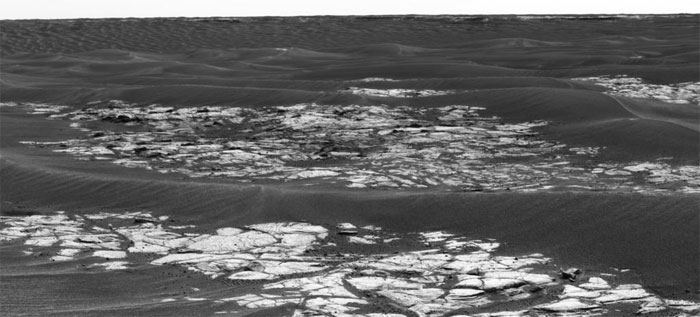New Target of Opportunity: Erebus Crater

Evenon Mars, size counts.
NASA'sOpportunity rover at MeridianiPlanum has wheeled up to "Erebus Crater" - a sizablefeature about 984 feet (300 meters) across.
Thedecision has been made by scientists and engineers operating the robot to go west,counterclockwise around the crater. Erebus is nearly twice the diameter ofEndurance Crater, an earlier "pit stop" of Opportunitythat produced a bonanza of science data.
"We'rethere, for all intents and purposes," said Steve Squyresof Cornell Universityin Ithaca, New York. Squyresis principal investigator for the Opportunityand Spirit Mars rover science instruments.
"Wecan see most of the crater from where we are right now, and we've made thedecision that we're going to traverse around it on its western side," Squyres told SPACE.com. "We're actually going tostart the drive around the crater by going north a little bit...to get ontoterrain that's mostly bedrock...before we swing west."
Squyres said that as Opportunitymakes its way counterclockwise around the crater, the science team and roverdrivers are keeping their eyes sharp, looking for a safe place to possiblyenter Erebus Crater.
"Thegoal being to get to a place we've named the 'MogollonRim'...on the western side. If we can find a safe place to go in, that's great...if we can't, we'll just continue on to the south," Squyresadded.
Breaking space news, the latest updates on rocket launches, skywatching events and more!
Nasty-looking places
Onthe other side of Mars--within Gusev Crater--the Spiritrobot has been intently surveying the summit of Husband Hill.
Sessionwork has included studying "Cliffhanger"--a windblown drift. Stereo imaging of "Tennessee Valley" from the summit is also on theaction item list.
Increasedattention is being paid on how best to get down from the summit, Squyres noted in an update on the Cornell University-basedMars Exploration Rover website. Which way to go and what route should be pickedare under discussion, he reported.
"Thehill is very steep in places....and the orbital images show a lot of tastygeology, some of it in pretty nasty-looking places. All in all, the nextseveral weeks are going to present us with some of the most interestingroute-finding decisions that we've faced in a long time, on both sides of theplanet," Squyres noted.
Meteor search campaign
Spirithas also turned nighttime sky-watcher. The Mars machinery is engaged in"shooting sessions"--not only imaging the two moons of the red planet, Phobos and Deimos, but will alsobe on the lookout for shooting stars.
"We'realmost done with our Phobos and Deimosastrometric and color imaging," said Jim Bell, anAssociate Professor in the Cornell University Astronomy Department. Bell is lead scientist for the Panoramic Camera colorimaging system carried by both Spirit and Opportunity.
"Wehave a few more sequences to run...and we'll also be trying to image Phobos going into and out of the Mars shadow in a 'lunar'eclipse later in October for additional orbit timing data," Bell explained.
"Nextwe are going to start our meteor search campaign in earnest," Bell told SPACE.com. "We have tofinish up our nighttime observation campaigns relatively soon. That's becausewe're at the peak of our power availability now on Spirit over the comingmonths, as the Sun starts to get lower and Mars gets farther from the Sun."
Bell said roverengineers for Spirit may not be able to muster enough power to operate thecameras at night. "So the clock is ticking," he added.
Backon the other side of Mars, nighttime observations of the martian sky by Opportunity for a longer period oftime may be possible, Bellsaid, because that rover is closer to the equator. However, Opportunityis also dealing with a power-draining heater unit. It is stuck in the onposition. Too early to tell if that situation may deter the robot's nighttimesky scanning, he said.

Leonard David is an award-winning space journalist who has been reporting on space activities for more than 50 years. Currently writing as Space.com's Space Insider Columnist among his other projects, Leonard has authored numerous books on space exploration, Mars missions and more, with his latest being "Moon Rush: The New Space Race" published in 2019 by National Geographic. He also wrote "Mars: Our Future on the Red Planet" released in 2016 by National Geographic. Leonard has served as a correspondent for SpaceNews, Scientific American and Aerospace America for the AIAA. He has received many awards, including the first Ordway Award for Sustained Excellence in Spaceflight History in 2015 at the AAS Wernher von Braun Memorial Symposium. You can find out Leonard's latest project at his website and on Twitter.
